|
|
|
Sort Order |
|
|
|
Items / Page
|
|
|
|
|
|
|
| Srl | Item |
| 1 |
ID:
104341
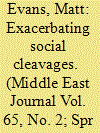

|
|
|
|
|
| Publication |
2011.
|
| Summary/Abstract |
This article challenges the traditional model of the media as a positive agent for political socialization. The increasing variety of news sources has reversed the role of the media, contributing to growing cultural fragmentation, rather than the unification of nations. One of the most volatile cultural cleavages in countries around the world is the clash between fundamentalist and secular members of the same religion. This work explores the role of the media in societal rifts through a study of the secular and religious press in Israel. The potentially divisive impact of the media has implications for other countries in the Middle East that are also characterized by religious-secular tensions.
|
|
|
|
|
|
|
|
|
|
|
|
|
|
|
|
| 2 |
ID:
127637
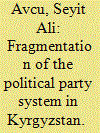

|
|
|
|
|
| Publication |
2013.
|
| Summary/Abstract |
A political party system is the nature and relations of the political parties in a given political system. There are four main variables in the classification of party systems: the extent to which parties penetrate society, the ideologies of the parties, the stance of the parties toward the legitimacy of the regime, and the number of parties in the system. The number of parties determines the level of fragmentation of the party system. Kyrgyzstan emerged as an independent country after the collapse of the Soviet Union. After two revolutions, which resulted in the ousting of the presidents, Kyrgyzstan officially changed its political system by announcing the introduction of parliamentary democracy and held its first elections after the regime change in October 2010. Five parties were able to pass the 5% national threshold to gain seats in the parliament. However, no single party gained enough of a majority to form the government on its own. Therefore, they formed coalitions, the latest of which includes three parties-the SDPK, Ar-Namys, and Ata-Meken-while the other two remained in the opposition: Respublika and Ata-Jurt. I estimated the effective number of parties by votes and seats and the least squares index for the 2010 parliamentary elections using Michael Gallagher's index, which utilizes the Laakso-Taagepera formula. The effective number of parties' index in Kyrgyzstan in terms of seat distribution in the Jogorku Kenesh was 4.90 for the 2010 parliamentary elections. However, the effective number of parties' index in terms of votes received by the parties is much higher: 9.86. On the other hand, the least squares index, which measures the disproportionality of the election results, is 13.75, which indicates the existence of many small parties with no seats. The 5% national threshold played a role in this disproportionality. The thesis of this article is that Kyrgyzstan's political party system is highly fragmented, and both institutional factors, such as constitutional and political party laws and the electoral system, and structural factors, such as social and political cleavages, play a role in this fragmentation.
|
|
|
|
|
|
|
|
|
|
|
|
|
|
|
|
| 3 |
ID:
094421
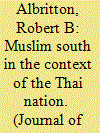

|
|
|
|
|
| Publication |
2010.
|
| Summary/Abstract |
The years since 2004 have been marked by a level of insurgency in the southern region of Thailand unknown for decades. An accurate perspective on this conflict requires a deeper understanding of differences between the Buddhist and Muslim Thais of the region than has been evident in public and academic discourse. This study utilizes data from a survey taken in 2006, of attitudes and political orientations across all regions of Thailand, including an independent sample of the southern region. The data indicate that southerners are different from the rest of Thailand, whether Buddhist or Muslim; that Malay-speaking Muslims are different from other Muslims; and that sympathy for the insurgency lies not in religion, but in defending practices associated with loyalty to specific forms of Malay culture that characterize the region.
|
|
|
|
|
|
|
|
|
|
|
|
|
|
|
|
| 4 |
ID:
139473
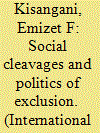

|
|
|
|
|
| Summary/Abstract |
The central African republic(CAR) became independent in August 1960.
|
|
|
|
|
|
|
|
|
|
|
|
|
|
|
|
| 5 |
ID:
141227
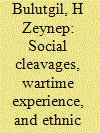

|
|
|
|
|
| Summary/Abstract |
What explains ethnic cleansing? Recent research has used systematic evidence to explore the causes of civilian victimization and mass killings. Yet, comparable studies that focus on ethnic cleansing are still rare. This article conceptualizes ethnic cleansing as a group-level phenomenon that is distinct from civilian victimization or mass killings and studies its causes by using systematic evidence from Europe 1900–2000. The article makes two theoretical moves. First, it highlights the salience of non-ethnic cleavages such as social class as a background condition that has the ability to hinder ethnic cleansing. Second, it distinguishes between two causal mechanisms, one that considers wars as ‘strategic environments’ and the other as ‘transformative experiences’, that relate to the proximate causes of ethnic cleansing. Using original data from 20th-century Europe, the empirical analysis offers two main findings. First, it shows that salient social cleavages, measured through levels of land inequality, political competition, and support for left-wing parties, substantially decrease the risk of ethnic cleansing. Second, the analysis suggests that the arguments that underscore psychological mechanisms related to wartime experiences provide a better explanation for ethnic cleansing than the arguments that emphasize the role of strategic wartime aims. This finding is further supported by a brief discussion of key cases in which both causal mechanisms predict ethnic cleansing. The results highlight the importance of treating ethnic cleansing as a conceptually separate phenomenon and offer implications for the debate on democracy and mass ethnic violence.
|
|
|
|
|
|
|
|
|
|
|
|
|
|
|
|
| 6 |
ID:
078068


|
|
|
|
|
| Publication |
2007.
|
| Summary/Abstract |
A new conventional wisdom characterizes the comparative study of electoral politics. Social cleavages, once a stabilizing factor of electoral behavior in Western Europe, are on the wane. Voting decisions have become individualized and old social cleavages have been superseded by new value-related cleavages. This article challenges that view as an exaggeration
|
|
|
|
|
|
|
|
|
|
|
|
|
|
|
|
| 7 |
ID:
078405


|
|
|
|
|
| Publication |
2007.
|
| Summary/Abstract |
A stable and effective party system depends on consistent and enduring support from social groups. Using the Lipset-Rokkan paradigm as a point of departure, this article tests the relationship between social structure and party support in four East Asian democracies (Japan, South Korea, the Philippines, and Taiwan) and two Western democracies (Australia and New Zealand) using the Comparative Study of Electoral Systems. UsingAustralia and New Zealand as a reference point, the results show that the four Lipset-Rokkan social cleavages are only loosely related to party support in the four East Asian nations, mainly through center-periphery and urban-rural divisions. The absence of an owner-worker cleavage is explained by the suppression of labor-based parties in these countries. More generally, the results suggest the importance of the socializing experiences associated with the democratic transitions in each of the four newer democracies
|
|
|
|
|
|
|
|
|
|
|
|
|
|
|
|
|
|
|
|
|